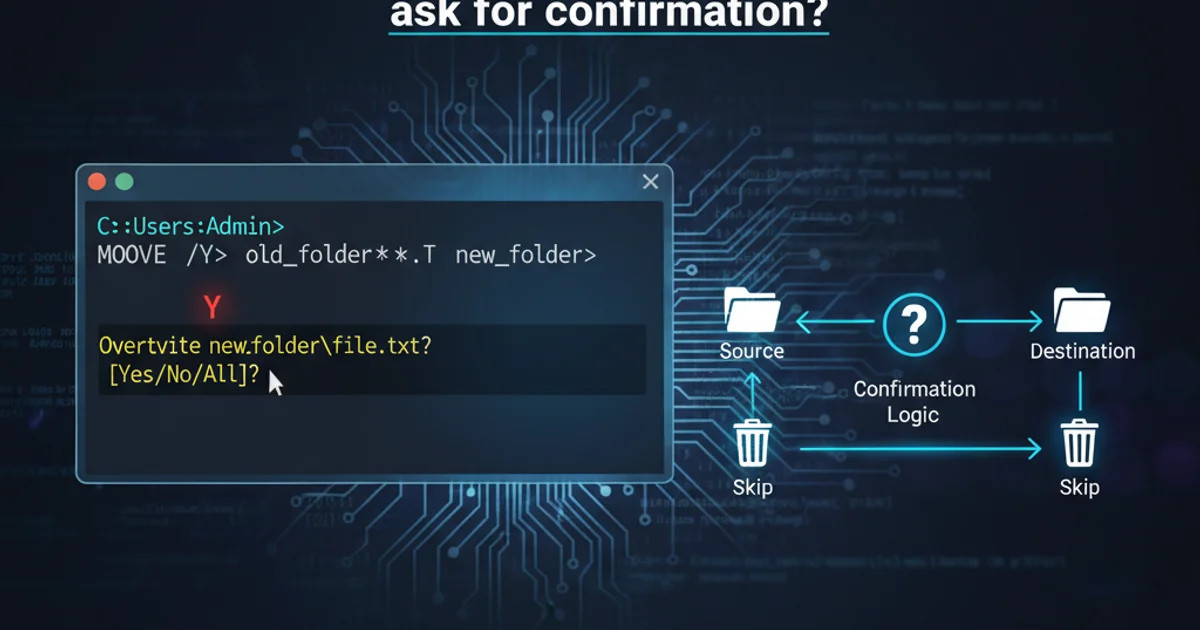Why does the CMD command "MOVE /Y" ask for confirmation?
Categories:
Understanding the 'MOVE /Y' Confirmation Prompt in CMD

Explore why the MOVE /Y command in Windows Command Prompt sometimes prompts for confirmation, despite the /Y switch, and how to effectively manage file movements without unexpected interruptions.
The MOVE command in Windows Command Prompt is a fundamental utility for relocating files and directories. When automating tasks with batch scripts, the /Y switch is commonly used to suppress confirmation prompts when overwriting existing files. However, users often encounter situations where MOVE /Y still asks for confirmation, leading to unexpected pauses in their scripts. This article delves into the nuances of the MOVE command's behavior, explaining why these prompts occur and how to ensure truly silent file operations.
The Purpose of the /Y Switch
The /Y switch is designed to prevent MOVE from prompting you before overwriting an existing destination file. Without /Y, if a file with the same name already exists at the target location, MOVE will ask for confirmation (e.g., Overwrite [filename]? (Yes/No/All):). The /Y switch tells the command to automatically answer 'Yes' to such prompts, making the operation non-interactive.
:: Example of MOVE without /Y
MOVE source.txt destination\source.txt
:: Example of MOVE with /Y to suppress overwrite prompt
MOVE /Y source.txt destination\source.txt
Basic usage of the MOVE command with and without the /Y switch.
When MOVE /Y Still Prompts for Confirmation
Despite the /Y switch, there are specific scenarios where MOVE will still prompt for user input. These situations typically arise not from file overwrites, but from other types of conflicts or conditions that the /Y switch is not designed to handle. Understanding these edge cases is crucial for robust scripting.
flowchart TD
A[Start MOVE /Y command] --> B{Destination file exists?}
B -->|Yes| C{Is it an overwrite?}
C -->|Yes| D[Overwrite without prompt (due to /Y)]
C -->|No| E{Is destination a directory?}
E -->|Yes| F[Move file into directory]
E -->|No| G{Is source a directory and destination a file?}
G -->|Yes| H["Prompt: Cannot move directory over file (Error)"]
G -->|No| I{Is destination read-only?}
I -->|Yes| J["Prompt: Access Denied (Error)"]
I -->|No| K{Is destination in use?}
K -->|Yes| L["Prompt: The process cannot access the file (Error)"]
K -->|No| M[Move successful]
B -->|No| MDecision flow for MOVE /Y command, highlighting scenarios that still prompt.
Common reasons for unexpected prompts include:
- Moving a directory over an existing file: If you try to move a directory and specify a destination that is an existing file (not a directory),
MOVEwill prompt with an error message likeCannot move directory over file. The/Yswitch does not bypass this logical conflict. - Access Denied: If the destination file or directory is read-only, locked by another process, or you lack the necessary permissions,
MOVEwill fail and might display an error message that requires acknowledgment, effectively acting as a prompt. - Insufficient Disk Space: While less common for a direct prompt, if the destination drive runs out of space during the move, the operation will fail, and an error message might appear.
- Invalid Path or Filename: If either the source or destination path is invalid or contains illegal characters,
MOVEwill report an error, which can halt script execution.
MOVE operations.Strategies for Truly Silent File Operations
To achieve truly silent file operations in batch scripts, you need to anticipate and handle these edge cases. Combining MOVE /Y with other commands and error handling techniques can prevent unexpected prompts.
@ECHO OFF
SETLOCAL
SET "source_file=C:\temp\my_file.txt"
SET "destination_dir=C:\target_folder"
SET "destination_file=%destination_dir%\my_file.txt"
:: Ensure destination directory exists
IF NOT EXIST "%destination_dir%" (
MD "%destination_dir%"
IF ERRORLEVEL 1 (
ECHO ERROR: Could not create destination directory "%destination_dir%"
GOTO :EOF
)
)
:: Check if destination file exists and delete if necessary (for robustness)
IF EXIST "%destination_file%" (
ATTRIB -R "%destination_file%" 2>NUL
DEL /F /Q "%destination_file%" 2>NUL
IF EXIST "%destination_file%" (
ECHO WARNING: Could not delete existing destination file "%destination_file%"
GOTO :EOF
)
)
:: Attempt the move operation with /Y
MOVE /Y "%source_file%" "%destination_dir%" >NUL 2>&1
IF ERRORLEVEL 1 (
ECHO ERROR: Failed to move "%source_file%" to "%destination_dir%"
) ELSE (
ECHO Successfully moved "%source_file%" to "%destination_dir%"
)
ENDLOCAL
Robust batch script for silent file movement, including checks for directory existence and pre-deletion of target file.
In the example above:
@ECHO OFFand>NUL 2>&1are used to suppress command output and error messages from appearing on the console.IF NOT EXISTchecks ensure the destination directory is present.ATTRIB -RandDEL /F /Qare used to forcefully remove any existing read-only or locked files at the destination, preventing potentialAccess DeniedorOverwriteprompts thatMOVE /Ymight not fully handle if the file is read-only.IF ERRORLEVEL 1checks for errors after theMOVEcommand, allowing the script to handle failures gracefully rather than halting with a prompt.
DEL /F /Q can be destructive. Ensure you are absolutely certain that you want to delete any existing file at the destination before implementing this in production scripts. Always back up critical data.